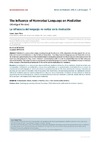Please use this identifier to cite or link to this item:
https://accedacris.ulpgc.es/jspui/handle/10553/15952
| DC Field | Value | Language |
|---|---|---|
| dc.contributor.author | López-Viera, Laura | en_US |
| dc.date.accessioned | 2016-02-29T09:01:55Z | |
| dc.date.accessioned | 2018-03-15T14:36:17Z | - |
| dc.date.available | 2016-02-29T09:01:55Z | |
| dc.date.available | 2018-03-15T14:36:17Z | - |
| dc.date.issued | 2016 | en_US |
| dc.identifier.issn | 2340-9754 | en_US |
| dc.identifier.uri | https://accedacris.ulpgc.es/handle/10553/15952 | - |
| dc.description.abstract | Mediation is a process that assigns meaning through the discourse of the disputants whereby signals that are verbally sent become rare indicators to dig for full communication. If reading nonverbal language was not taken into account, we would lose approximately 93% of the total information conveyed by someone; for this reason, it is necessary to know the most recurrent gestures to, thus, foster mediators’ communication skills in order to substantially improve their discourse and understanding. This paper focuses on arguing why nonverbal language is crucial for the mediation process on the basis of the analysis of the theoretical framework of the matter and its implications for mediation. | en_US |
| dc.language | eng | en_US |
| dc.relation.ispartof | Revista De Mediacion | en_US |
| dc.source | Revista de Mediación [ISSN 2340-9754], v. 8 (2), e6 | en_US |
| dc.subject | 61 Psicología | en_US |
| dc.subject.other | Mediación | en_US |
| dc.subject.other | Paralanguage | en_US |
| dc.subject.other | Kinesics | en_US |
| dc.subject.other | Proxemics | en_US |
| dc.subject.other | FACS (Face Action Coding System) | en_US |
| dc.title | The influence of nonverbal language on mediation | en_US |
| dc.type | info:eu-repo/semantics/article | en_US |
| dc.type | Article | en_US |
| dc.identifier.crisid | - | |
| dc.identifier.issue | 2 | - |
| dc.relation.volume | 8 | - |
| dc.investigacion | Ciencias Sociales y Jurídicas | en_US |
| dc.rights.accessrights | info:eu-repo/semantics/openAccess | es |
| dc.type2 | Artículo | en_US |
| dc.identifier.ulpgc | Sí | es |
| item.fulltext | Con texto completo | - |
| item.grantfulltext | open | - |
| Appears in Collections: | Artículos | |
Page view(s)
177
checked on May 17, 2025
Download(s)
145
checked on May 17, 2025
Google ScholarTM
Check
Share
Export metadata
This item is licensed under a Creative Commons License

